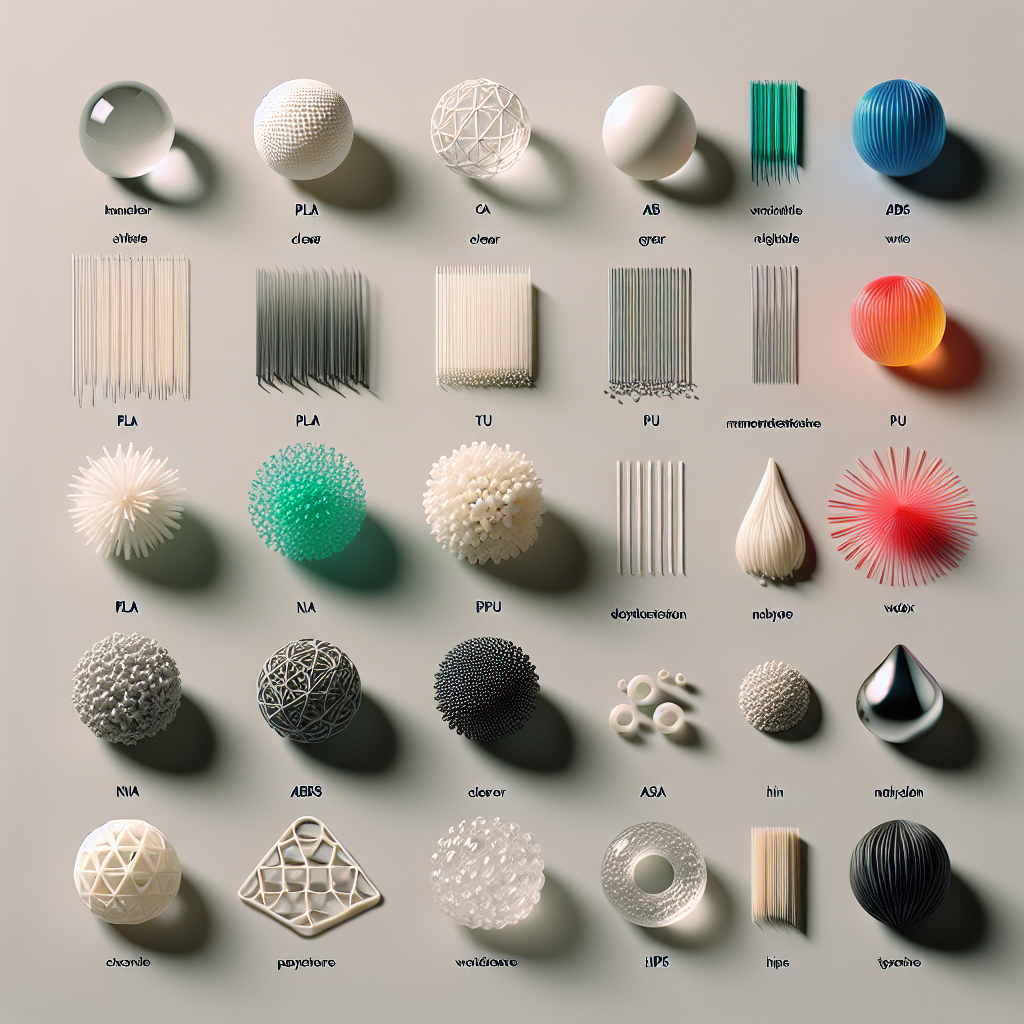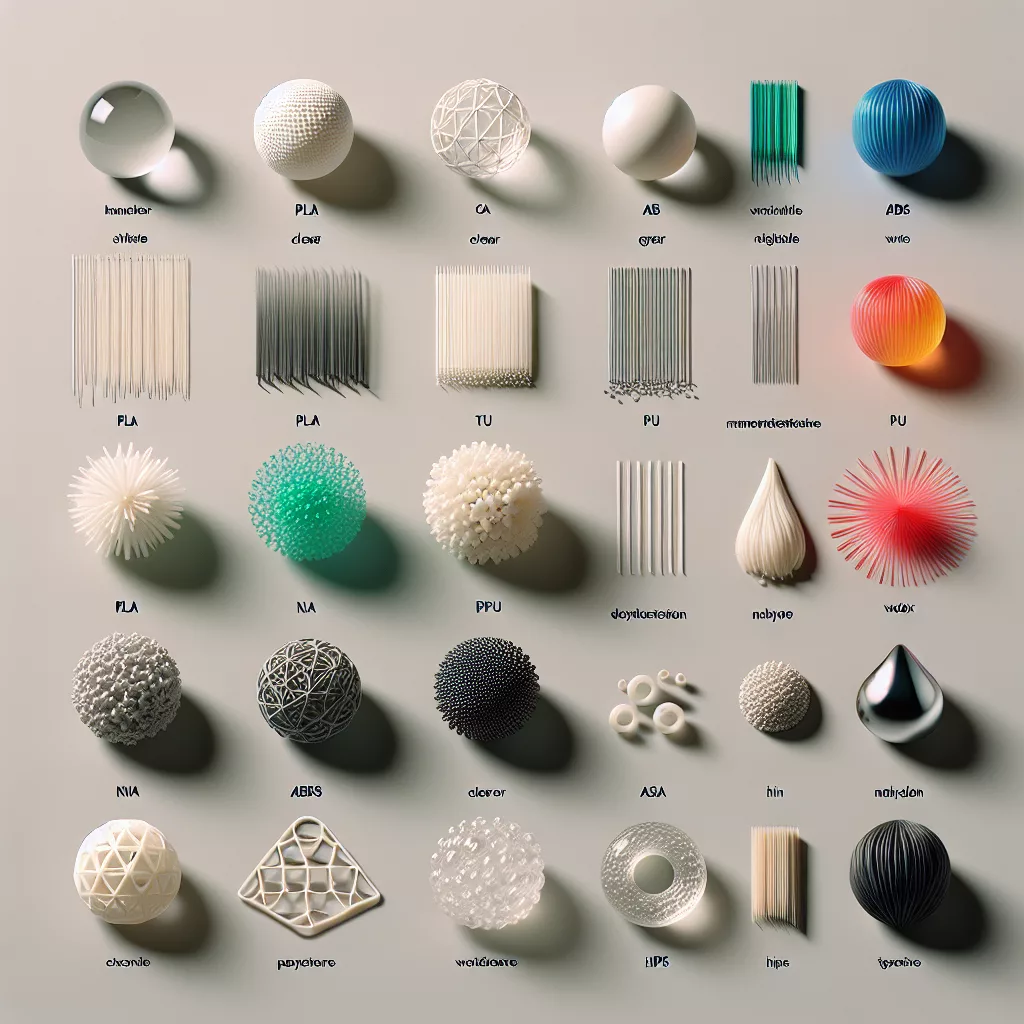Introduction
When it comes to the exciting world of 3D printing, choosing the right filament is crucial. The filament you select can greatly impact the strength, flexibility, detail, and usability of your 3D printed parts. With so many filament types available, each with their own unique properties and best-use scenarios, understanding their differences can vastly improve your 3D printing projects.
In this article, we will explore the top 10 popular 3D printing filaments and discuss their characteristics, advantages, disadvantages, and recommended uses.
1. PLA (Polylactic Acid)
PLA is the most common filament used in home 3D printing, known for its ease of use, affordability, and eco-friendliness. Derived from renewable resources such as corn starch and sugarcane, PLA filament offers minimal warping, low odor, and a wide variety of colors and finishes.
- Advantages: Easy printing, low warp, eco-friendly, biodegradable
- Disadvantages: Brittle, lower heat resistance
- Best Uses: Prototypes, toys, decorative items, educational purposes
2. ABS (Acrylonitrile Butadiene Styrene)
ABS is one of the most common filaments used historically, appreciated for its strength, durability, and heat resistance. ABS is petroleum-based and requires a heated bed and proper ventilation due to fumes during printing.
- Advantages: Strength, heat resistance, durability, affordable
- Disadvantages: Warping tendency, emits fumes when printing, requires ventilation
- Best Uses: Functional prototypes, automotive parts, mechanical assemblies, casings
3. PETG (Polyethylene Terephthalate Glycol)
PETG combines the ease of printability of PLA with the strength and durability of ABS. It is food-safe, resistant to water and chemicals, and offers good flexibility.
- Advantages: Strong yet flexible, durable, food-safe, good chemical resistance
- Disadvantages: Slightly stringy during printing, can stick strongly to build platform
- Best Uses: Mechanical components, food containers, bottles, protective cases
4. TPU (Thermoplastic Polyurethane)
TPU is a flexible, rubber-like filament known for its elasticity and shock-absorbent properties. TPU filament is perfect when you need a print to bend, flex, or absorb impacts.
- Advantages: Highly flexible, abrasion-resistant, durable, impact-absorbing
- Disadvantages: Challenging to print due to flexibility, slower printing speeds required
- Best Uses: Phone cases, wearable items, hinges, tires, gaskets, seals
5. Nylon (Polyamide)
Nylon is prized for its toughness, durability, and exceptional strength-to-weight ratio. It also has good chemical resistance and low friction properties.
- Advantages: High strength, flexibility, abrasion-resistant, chemical resistance
- Disadvantages: Hygroscopic (absorbs moisture), challenging to print, requires dry storage
- Best Uses: Functional prototypes, gears, mechanical parts, hinges, tools
6. ASA (Acrylonitrile Styrene Acrylate)
ASA is similar to ABS but is UV-resistant and weather-resistant. ASA filament is well-suited for outdoor applications and long-term exposure to sunlight and harsh weather.
- Advantages: UV and weather resistance, strong, durable, good temperature resistance
- Disadvantages: Fumes during printing, heated bed required, ventilation recommended
- Best Uses: Outdoor enclosures, automotive parts, garden accessories, outdoor signage
7. PC (Polycarbonate)
Polycarbonate filament provides excellent heat resistance and durability, while also being extremely strong and impact-resistant. It is commonly used in engineering applications where toughness and durability are critical.
- Advantages: High strength, impact resistance, temperature and chemical resistant
- Disadvantages: Difficult to print, requires higher print temperatures, prone to warping
- Best Uses: Engineering components, protective gear, automotive parts, electronic housings
8. PVA (Polyvinyl Alcohol)
PVA is a water-soluble filament designed to serve as support material during complex prints. It dissolves easily in warm water, allowing intricate designs and inaccessible supports to be easily removed.
- Advantages: Water-soluble, easy removal, ideal for complex multi-material prints
- Disadvantages: Hygroscopic, requires careful storage, limited shelf-life
- Best Uses: Support structures, intricate geometries, dual-extrusion prints
9. HIPS (High Impact Polystyrene)
HIPS is another filament commonly used as support material, typically paired with ABS. HIPS is dissolvable in limonene, making support removal easy and clean when printing complex ABS items.
- Advantages: Dissolvable supports, impact-resistant, easy to sand and finish
- Disadvantages: Requires limonene for dissolving, produces fumes during printing
- Best Uses: ABS support structures, prototypes, models needing fine finishing
10. Wood-Filled Filaments
Wood-filled filaments are composites of PLA mixed with finely ground wood particles, producing printed parts with realistic wood-like appearance, texture, and aroma. They are great for decorative objects and prototypes needing a natural aesthetic.
- Advantages: Real wood appearance, sandable and stainable, natural aesthetic
- Disadvantages: Nozzle wear, potential clogging, sensitivity to moisture
- Best Uses: Home décor, sculptures, artistic pieces, furniture prototypes
Conclusion
With such a wide variety of 3D printing filaments available, choosing the right type can seem overwhelming at first. However, by understanding each filament’s strengths, weaknesses, and optimal applications, you can significantly enhance the quality, durability, and aesthetics of your 3D printed projects. Whether you’re creating prototypes, functional mechanical parts, or artistic décor, selecting the appropriate filament can unlock your 3D printer’s full potential.


Leave a Reply